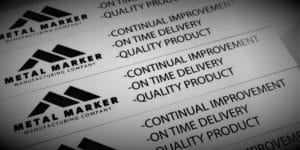Metal capacity plates are used to provide vital safety information to passengers and operators of machinery, transportation, and other equipment.
A capacity plate typically contains specific weight limitations and tolerances. This can be to prevent a machine from tipping, or a support from breaking.
Adhering to the specifications called out on capacity plates can mean the difference between safe usage and an injury or accident.
Applications
Forklifts
One of the most common usages for capacity plates, forklifts are often adorned with one of these metal tags.
If used improperly, forklifts can tip over, leading to injury or damage to property. This can also break or severely damage the machine itself.
OSHA specifically requires the usage of forklift plates in their 1910.178(a)(4) standard.
These nameplates must include safe handling weight without changing its center of gravity. It may also include fuel type, tire size, back tilt, lifting height, and more.
Boats
One of the most common uses for capacity placards is clearly indicating carrying capacity for watercraft. Boats must be marked with a permanent capacity plate near the steering area or the helm.
The information on the capacity plate contains details regarding the capabilities of the vessel. This can include power of the engine/motor, max number of passengers on the boat, max cargo size (weight), etc.
Following these guidelines is essential to maintaining safety on the water. If you overload a boat it can throw off the center of gravity, making it very top heavy and easy to tip over or capsize. In addition, overloaded cargo may cause unnecessary strain on the engine or motor, resulting in damage or failure.
Elevators
If you’ve ever ridden in an elevator, you’ve probably noticed a prominent sign indicating maximum capacity for the lift.
The American Society of Mechanical Engineers require this identification marking in their ASME A17.1 guidelines.
In addition, elevators are often equipped with other information on data code plates for operator and firefighter use, as well as emergency info for passengers.
Cell Phone Tower Equipment
Scaling high cell phone and utility towers is a potentially dangerous occupation which requires specific guidelines to be followed to prevent injury.
Special harnesses and other gear are relied upon to effectively scale these heights. This equipment must be used within the tolerances and specs the manufacturer provides.
Cell phone tower wire ropes are required to be equipped with a capacity plate which specifies the correct usage of climbing equipment.
Trying to overload equipment or skate by without following procedures can lead to a fatal mistake.
Construction Equipment
Heavy machinery is very likely to have capacity plates on it as well.
OSHA compliant sling and wire ropes used on construction sites are often fitted with capacity marking plates. These safety markers indicate the best way to maintain proper usage.
Construction nameplates often offer other information for operators such as manufacturer contact info or other data. These tags are often required by OSHA safety guidelines depending on the equipment or application.
Marking Processes
Photo Anodization
The most commonly used process for this type of identification, photo anodization provides an effective method for marking large amounts of information on a single plate.
These tags are customizable with any information required to meet specific guidelines. The design on the tag can even include a black background with “blank” spaces of the natural aluminum material. This allows for information to be added subsequent to receiving the nameplates.

The process embeds information within the aluminum itself, making the design incredibly resistant to wear.
Photo anodized plates are rated for 20+ years in outdoor environments, making them a highly effective solution for tough industrial conditions.
Screen Printing
Another marking process that is used for larger style designs, screen printing can produce a tag similar in appearance to one that is photo anodized.
Unlike photo anodizing, screen printed ink can include multiple colors. However, this comes at a drawback. Topically printed ink is not nearly as durable, and will quickly wear away if exposed to tough conditions.
Materials
The most commonly used materials for capacity style nameplates are anodized aluminum and stainless steel. Both metals offer outstanding durability and resistance to corrosion, however photo anodization is only available with aluminum material.
Wrap-Up
Capacity plates have uses spanning various industries and applications. From labeling boats to marking forklifts, they are vital to the safety of workers and passengers alike.
Ensure your organization meets all capacity labeling guidelines with custom capacity plates.